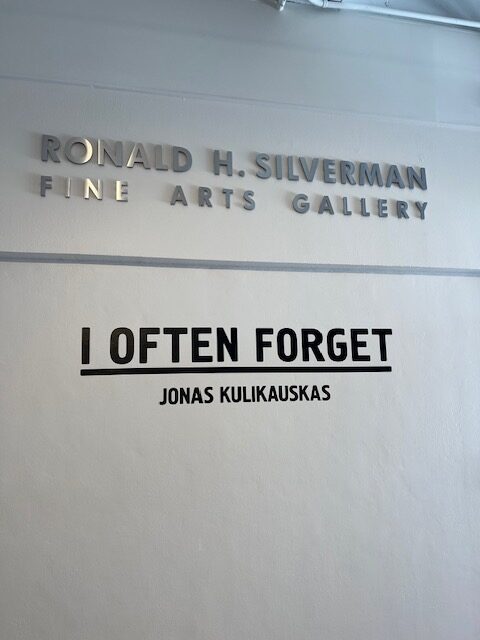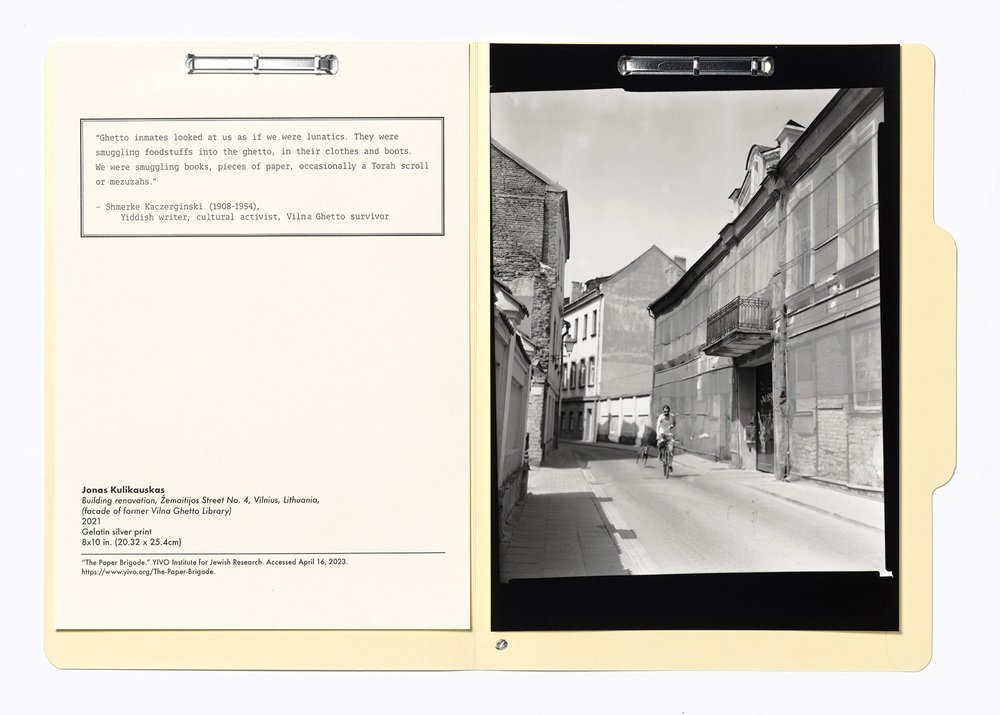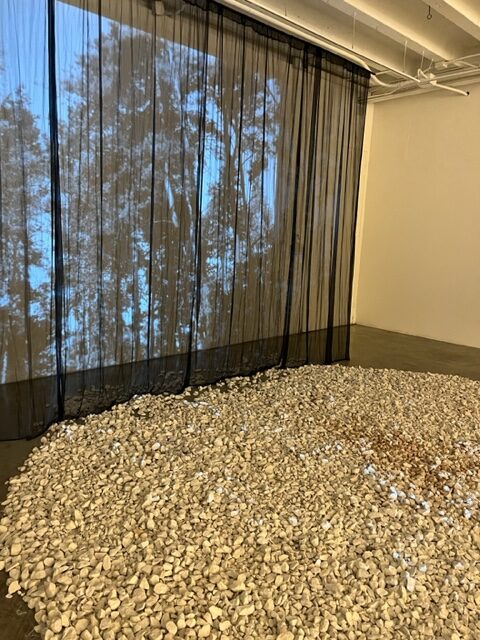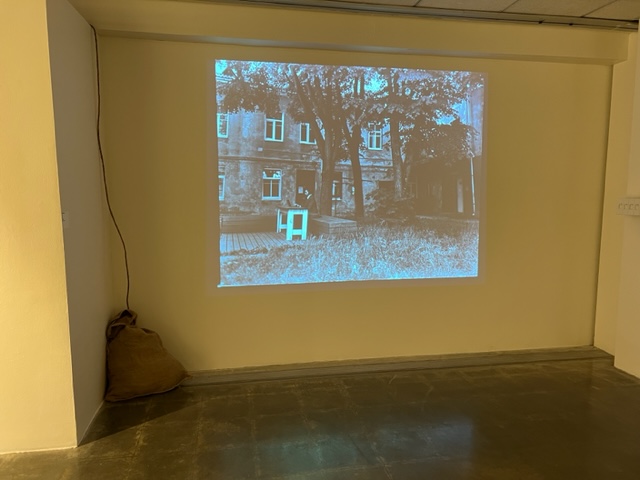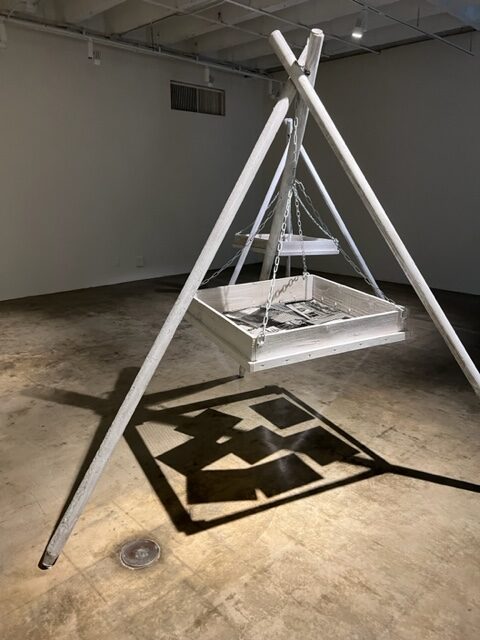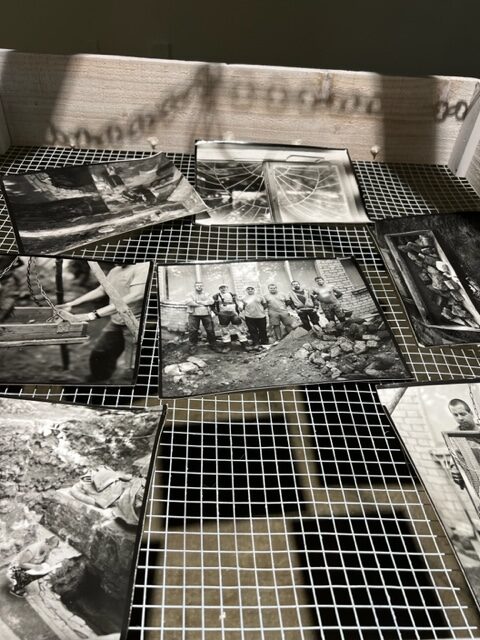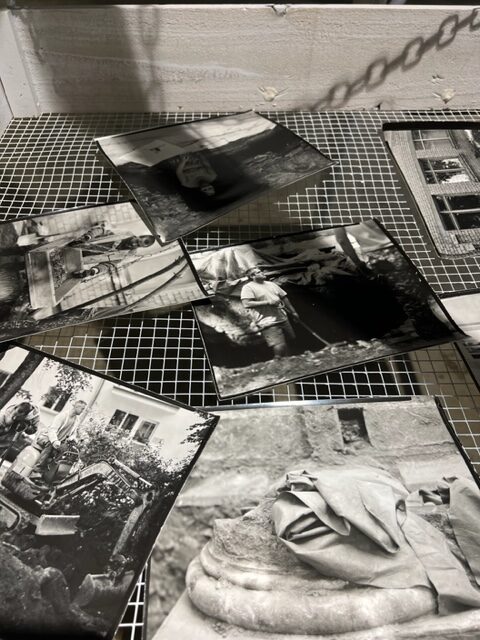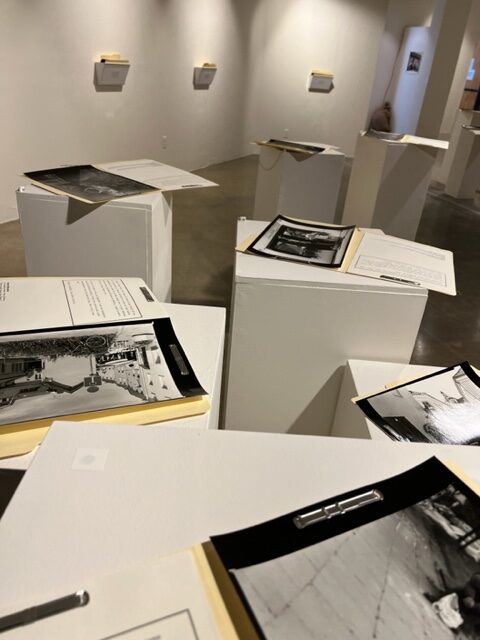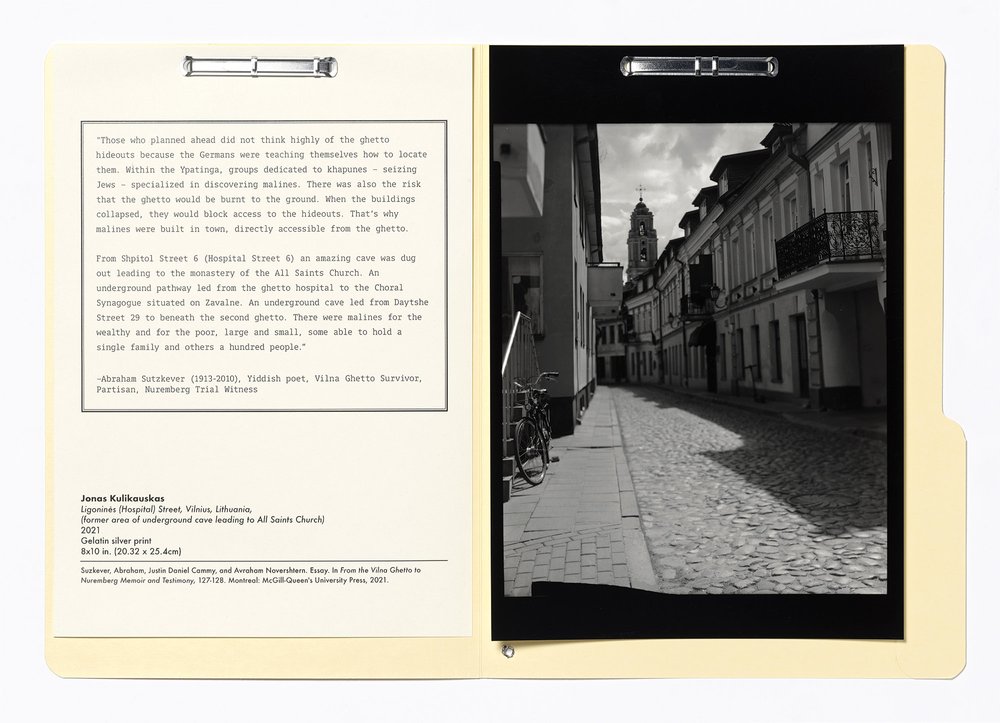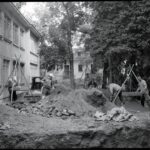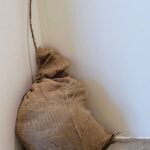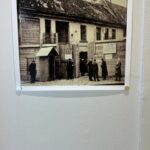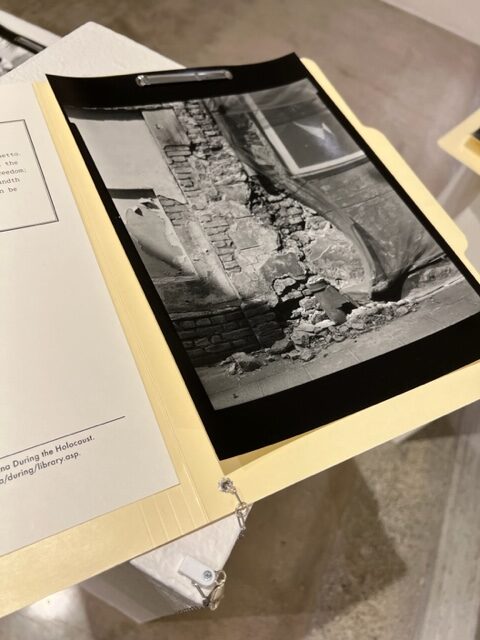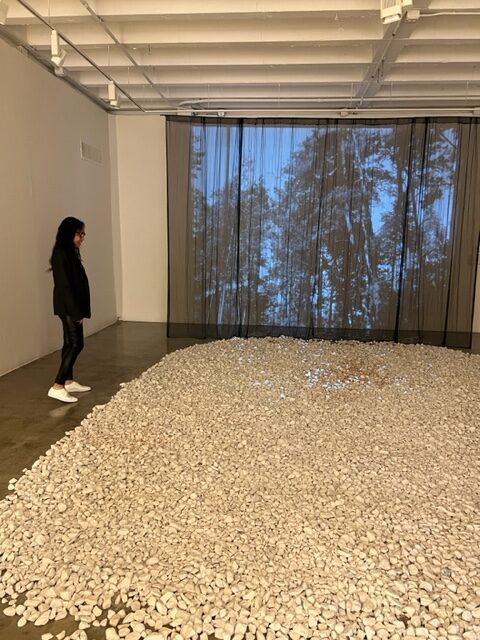States of Exception Offers Exceptional Vision: Written by Genie Davis
Moving, vibrant, and visionary, Susan Ossman’s States of Exception, at Cal State LA’s Ronald H. Silverman Gallery, serves as both a recent retrospective of the artist’s work, and as a poignant and prescient reminder of the varied circumstances and situations that affect not just our personal lives but all human life.
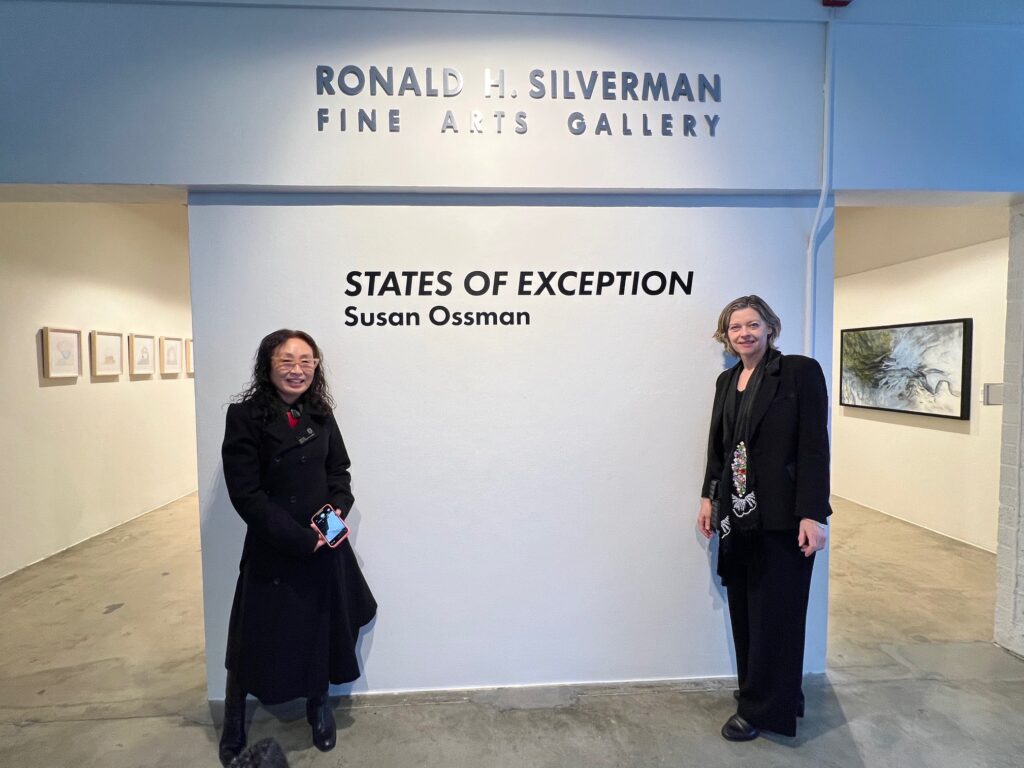
Ossman’s art is intensely experiential, taking viewers along with her on a ride through her own intimate experiences and those of others. Along the way she provides responses to political and social issues both timely and eternal, such as immigration and migration, health, personal freedom, the environment, the sheer wonder of the natural world, and humankind’s place in it and response to it.
As an artist, anthropologist, writer, and performer, Ossman has traveled the world and explored the various states of living in it, political, social, emotional, and geographic. Each of those subjects is conveyed through her lustrous and vivid paintings and installations.
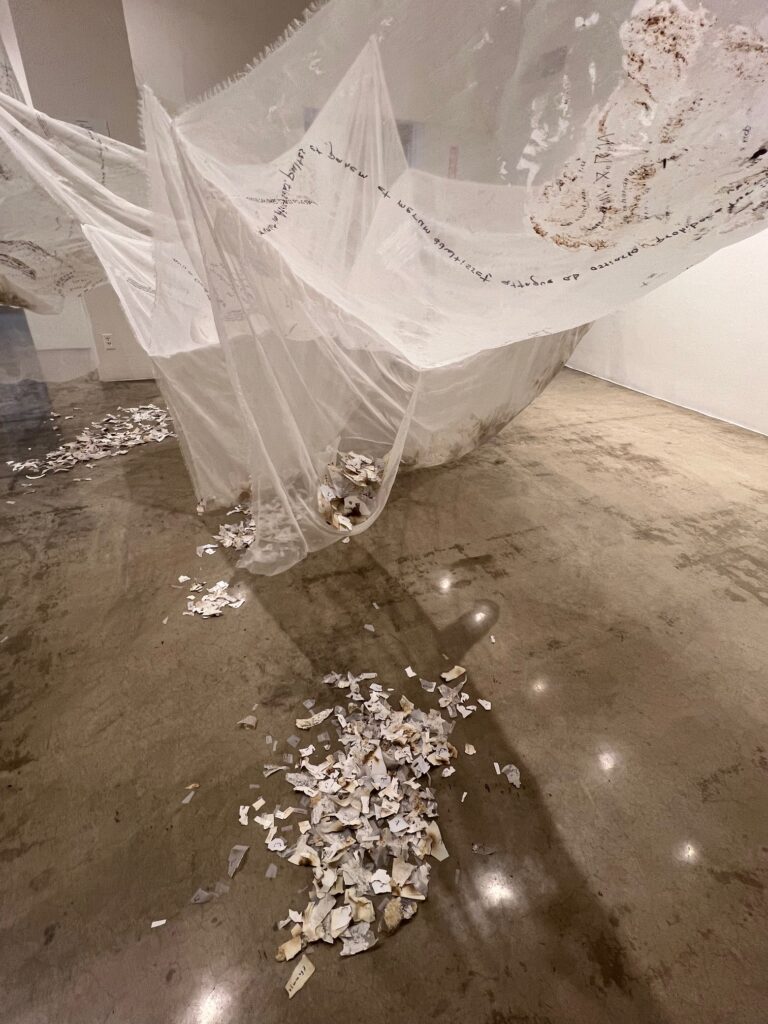
The exhibition follows an emotional and palette driven path rather than a specific timeline. Upon entering the gallery, “Mediterranean Sea Scroll” unfolds, a paper and ink on organza installation created in 2024. It’s a delicate and ephemeral piece, but it comes with a sturdy sense of place and the meaning inherent in it. A bibliography posted on the wall behind the work cites works such as The Great Sea, a History of the Mediterranean; the Dead Sea Scrolls; and Through the Eye of the Needle, Wealth, the Fall of Rome, and the Making of Christianity in the West, along with Don Quixote, and works by Camus and St. Augustine.
The burnt fragments of sentences and phrases that spill from the organza, as well as the delicate writing and shape- making on the fabric itself, have never been more timely. They are emblematic of the recent destruction from the fires in the Los Angeles area, including the devastating blazes in Altadena and the Pacific Palisades, reminiscent of paper bits, their edges burnt, floating on the wind during this recent cataclysmic. The work is not only meaningful and resonant, but in many ways prophetic, of both our history and our future.
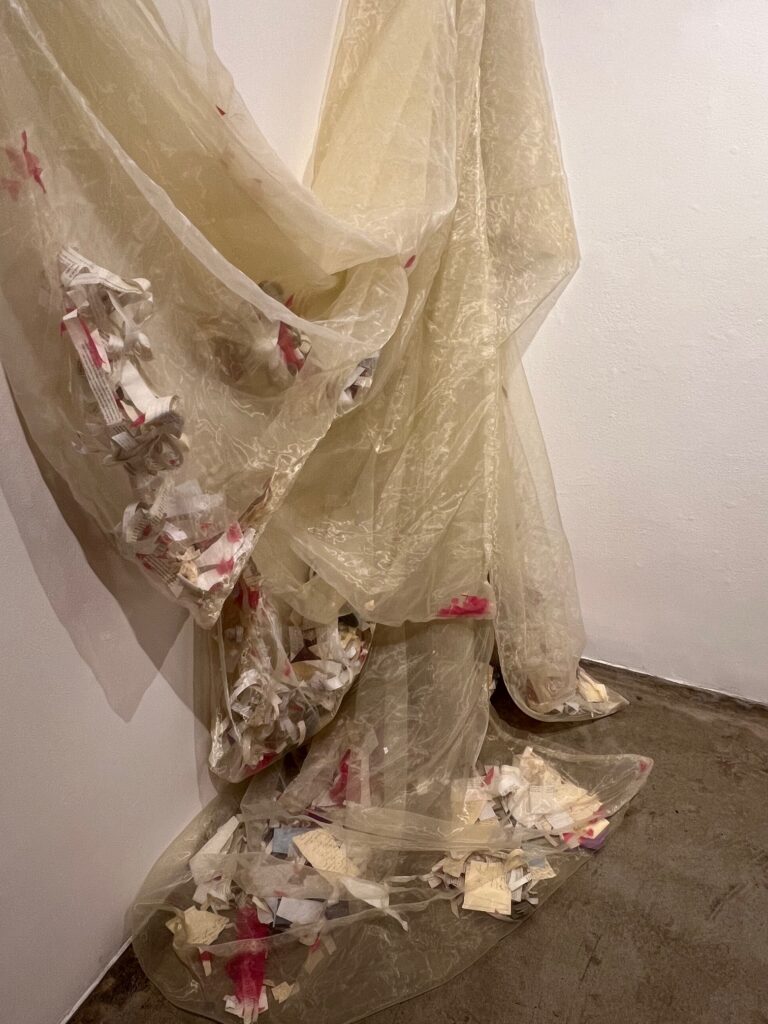
“What Goes Unsaid” (2013), above, is a smaller but remarkable installation. In this piece, Ossman is once again working with shreds of words and the gestural mystery which tumbles within the folds of the shroud-like fabric.
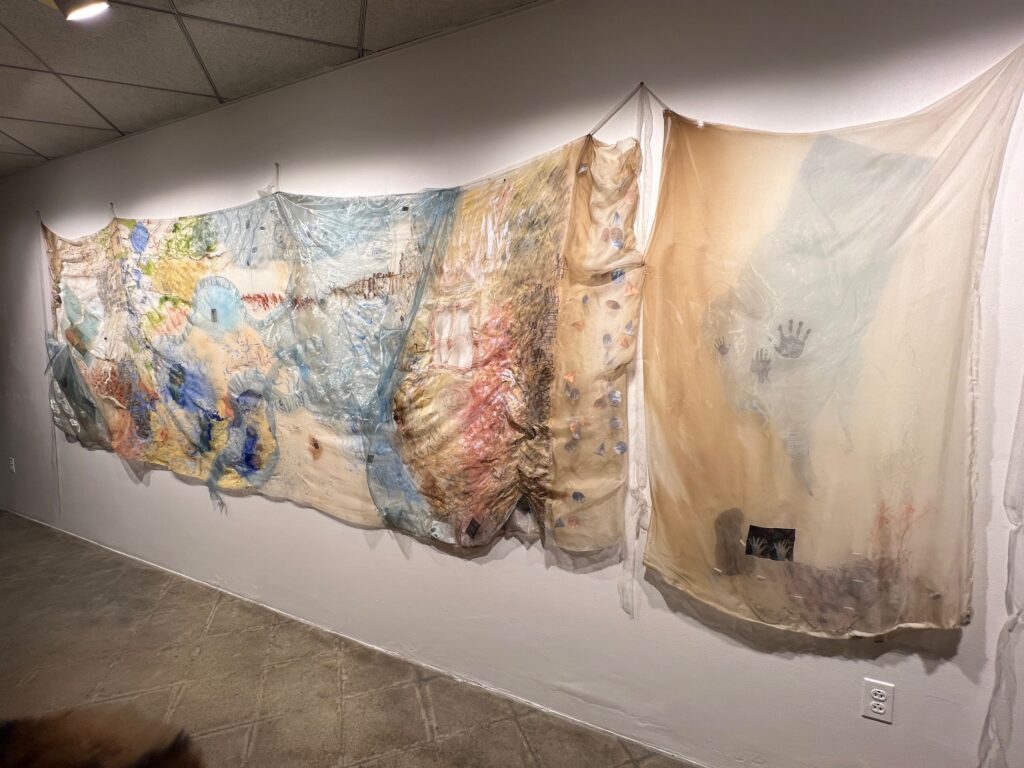
“Sources” (2018) is a large multi-media work on organza that once hung partially outdoors, and bears the marks of pollution, sun, and time on its fabric. Contained on it is the beautiful mapping of locations at every zip-code in which the artist has resided over her peripatetic life. It is shimmery and enormous, a banner and an inchoate flag of sorts, as resilient as it is malleable.
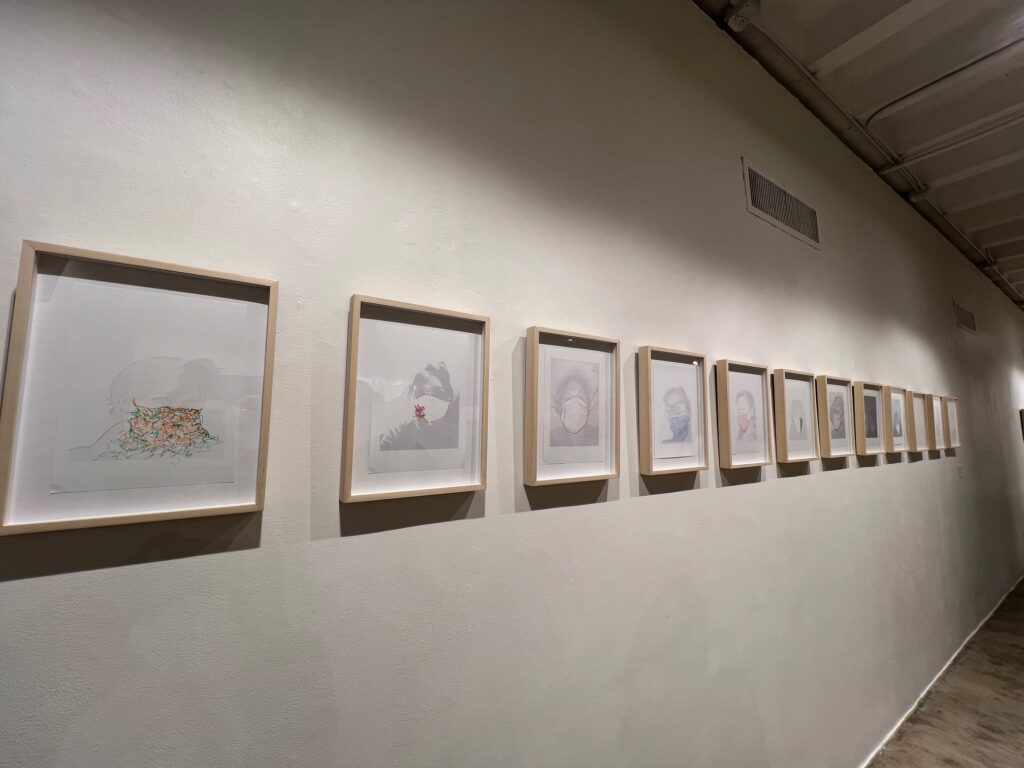
Also on exhibit is a series of small images of the artist herself, “Temporary Exhibition?” which was created as she underwent chemotherapy during the height of the COVID-19 pandemic. These hand-colored prints tell a profound and moving story of protecting oneself in the face of seemingly insurmountable obstacles.
Nearby, another hand-colored print on paper features the image of a yew tree – natural provider of a type of chemotherapy – and the text of a deeply moving poem, “Ode to If” created by Ossman. It reads, in part, “The cure destroys all that/grow in haste, ancient recipes…at times my body/ vibrates like lute strings echoed/in a slow-grown, yew-hewn chamber.” Similarly, her words and images vibrate within the viewer.
From the same 2021 time period, the artist created three acrylic and charcoal works on canvas, here unframed. “Restoration” offers a hopeful message of healing within its soaring red and orange center. The image resembles flames, branches of coral, and the ventricles and muscles of the heart. Created during the same year, other large-scale works speak to the process of cures and healing, with titles of “Infusions” and “Intoxication” that are as evocative as their carefully articulated sense of motion and flow, graceful but strong.
The artist’s “Chergui,” is something else again, a fierce 2014 oil on canvas work that sings with a vibrant, forceful red, recalling the desert wind for which it is named.
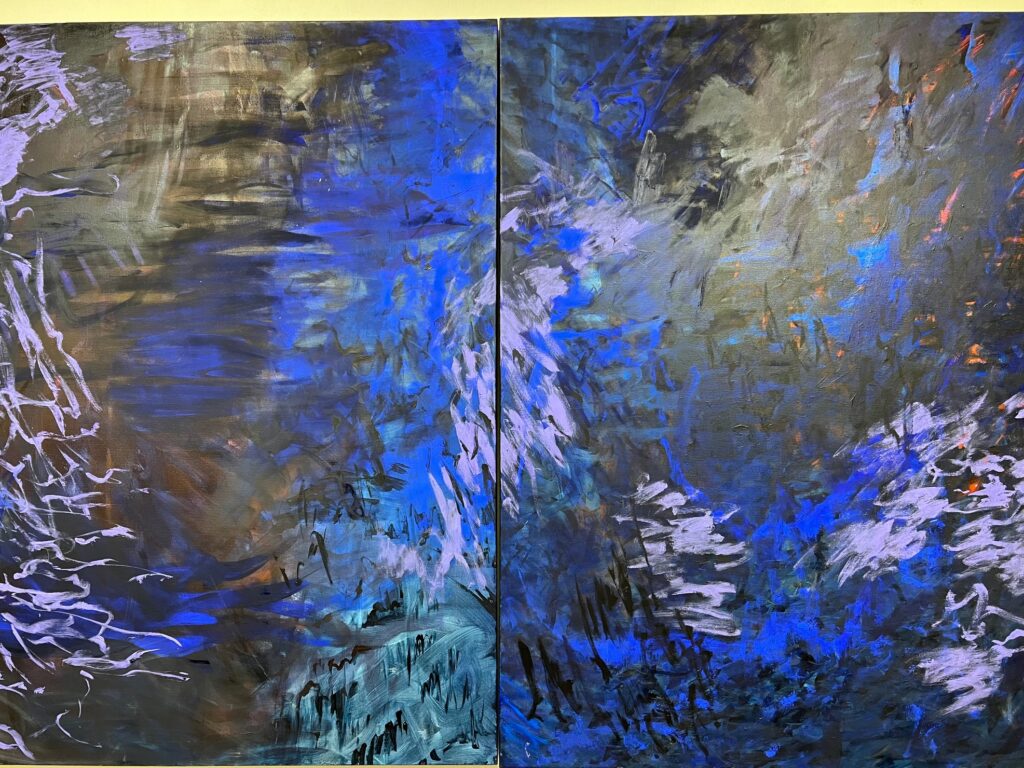
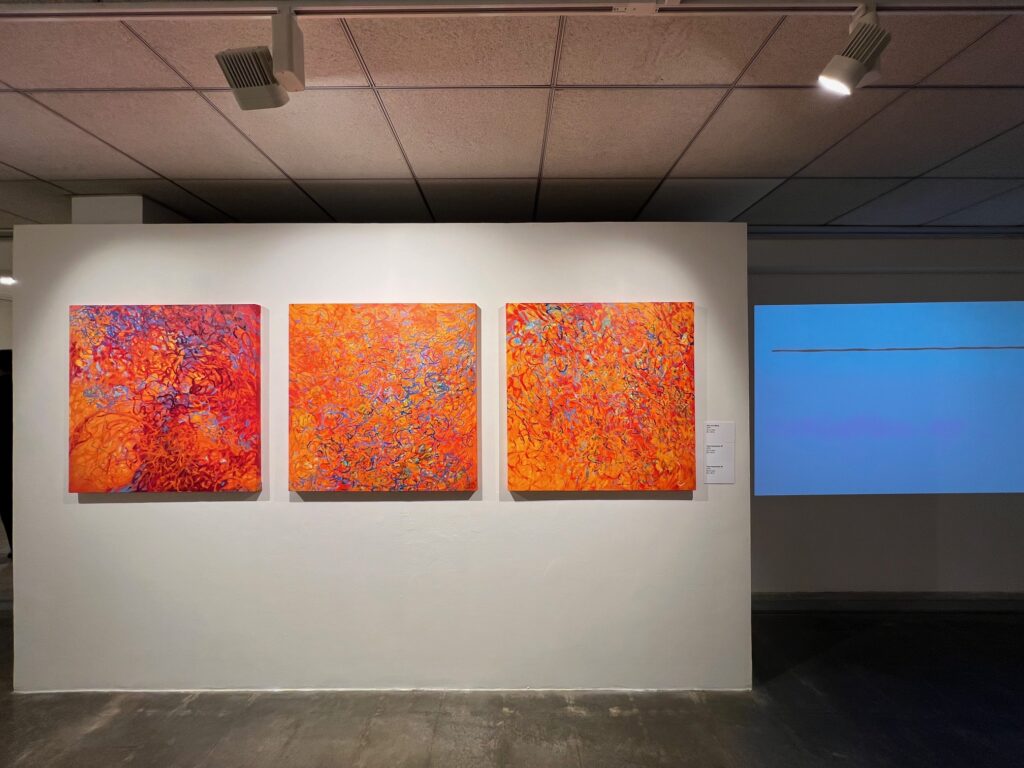
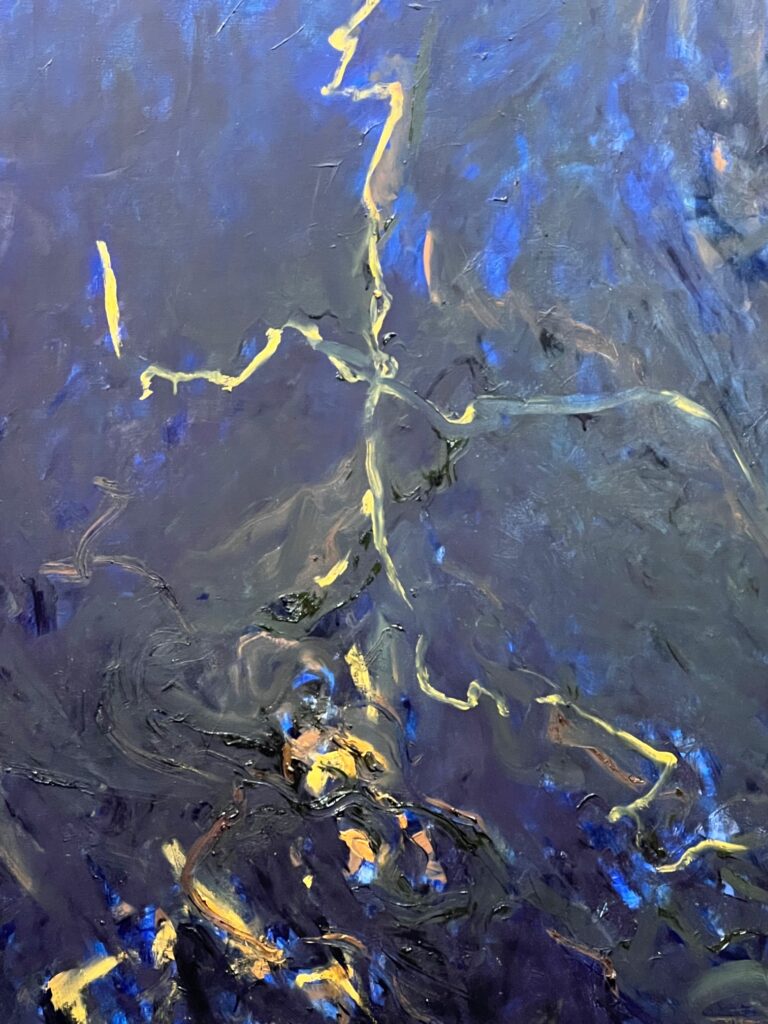
There are works aswirl with purple and lavender filaments, as in the solemn and lovely diptych “Bataclan;” and three blossoming orange works, including 2018’s “One and Many,” and 2019’s “Twin Intensities #1” and “Twin Intensities #2” that depict poppy fields, and all they represent – their beauty, their use in creating destructive drugs, their fragility and glory. There is another reference to the floral in the dark hues of “Flower Smoke” from the same year, which could speak to the use of opium made from poppies, or fields of flowers burnt in fires.
Nearby, Ossman projects a Power Point-created video that unfolds a highly pertinent and prescient poem, “Mere Anarchy? pas de deux,” the artist’s dialog with the poem “the second coming” by William Butler Yeats. One of my favorite lines is “He feared/The world he knew was ending.” Should we fear change? Ossman bears it, rides it out, and reshapes it if she can, through her art and spirit.
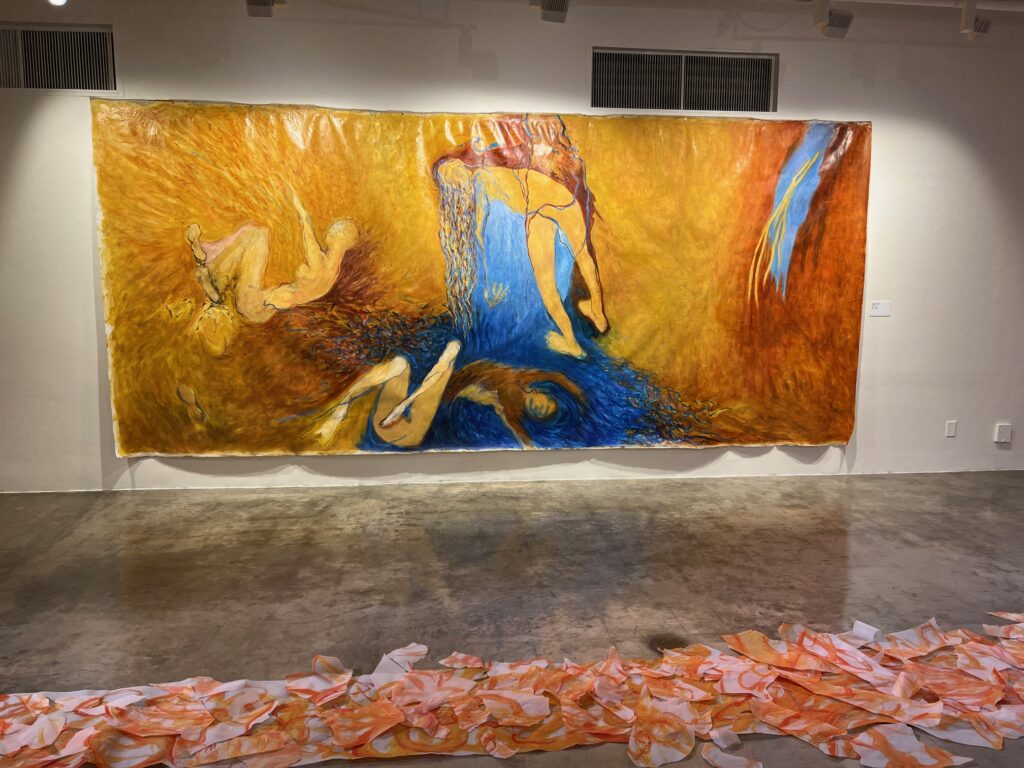
In the final room of the exhibition, there is the rather amazing, mesmerizing “Labor’s Lost” created last year. This large and uncharacteristically figurative work recalls some of Marc Chagall’s images, with its humans floating like balloons, bending in impossible positions. They move like dancers without the weight of gravity, or lean forward with dangling hair as if held by invisible strings. The horizontal oil on linen work is as filled with motion as the figures themselves, awash in golds, oranges, blues – all electric with energy.
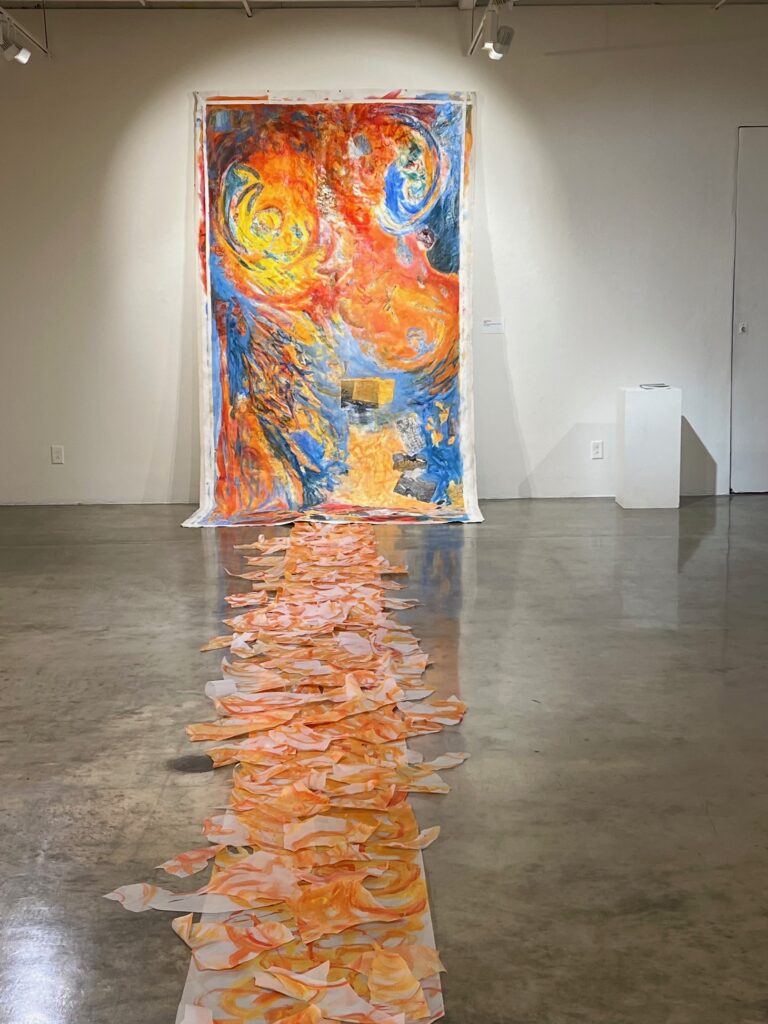
Also in the last exhibition gallery, there is the aptly titled “Conclusion” (2020). It is nearly as large a work as “Labor’s Lost,” but it is vertical, with floating objects rather than people. There are shapes and buildings, writings, implements, boxes. And spread out from this mysteriously alchemic world, running the length of this final room, is a wild and wonderful runner of orange and gold, a royal carpet of paper poppies that descends from the painting in a fabulous floral trail.
Richly expressive, universal, and yet highly intimate, States of Exception is that rare, truly compelling exhibition that showcases an artist finely attuned to both the natural and unnatural world, and the political, social, and spiritual constructs in which we all dwell. Curated by Mika Cho, this beautiful exhibition is on view at the Silverman until February 21st.
- Genie Davis; photos by Genie Davis





























































